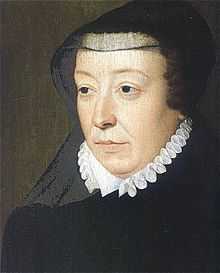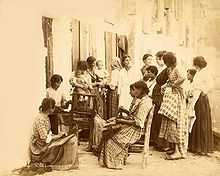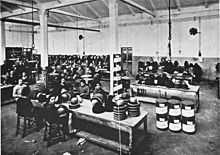Feminism in Italy
| Part of a series on | ||||||||
| Feminism | ||||||||
|---|---|---|---|---|---|---|---|---|
|
History
|
||||||||
|
||||||||
|
|
||||||||
|
By country |
||||||||
|
Lists and categories
|
||||||||
| Feminism portal | ||||||||
Feminism in Italy originated during the Italian renaissance period, beginning in the late 13th century.[1] Italian writers such as Christine de Pizan, Moderata Fonte, Lucrezia Marinella, and others developed the theoretical ideas behind gender equality. In contrast to feminist movements in France and United Kingdom, early women's rights advocates in Italy emphasized women's education and improvement in social conditions.[2]
Italian feminism suffered a setback under the Fascist government of Benito Mussolini in the first half of the twentieth century, with fascist ideology dictating procreation as a woman's duty.[3] In the post-war period, feminist movements surged, with public activism over issues such as divorce and abortion during the 1970s.[4] In recent years, Italian feminism has re-emerged, particularly during the administration of former Prime Minister Silvio Berlusconi, opposing objectification of women in national television shows and politics.[5]
History
Renaissance and Early Modern feminists
Renaissance thinkers regularly challenged conventional wisdom from the Medieval period and earlier. Humanism became the new way of looking at politics, science, the arts, education, and other fields. Humanism pushed aside the Medieval Christian concept of a hierarchical social order that placed regular citizens in a subservient position relative to members of the clergy. The Renaissance man was the ideal to emulate.
While the Renaissance humanists were for the most part "antifeminist",[6] there were a small number of educated women who had the motivation to challenge assumptions that women should remain submissive to men. Christine de Pizan wrote The City of Ladies in 1404, and in it she describes women's gender as having no innate inferiority to men's: "[N]either the loftiness nor the lowliness of a person lies in the body according to sex, but in the perfection of conduct and virtues".[6] However, she tempered her assertions by writing that men were created to rule, and women to follow.
Renaissance Italy saw the development of higher education, including the establishment of several universities, to which women were not admitted. Some fortunate women who could afford it were able to gain an education on their own, or had a father who allowed them to have some education through tutoring. The rare Renaissance man who supported education for women saw it as a way of improving her virtue, and to make her more obedient to her husband. Education intended to create leaders was seen as wasted on women.[7]
Although some women made a mark during the Renaissance as remarkable individuals within their local sphere, when taken collectively, the "rise of the educated woman during the Renaissance" can be traced.[8] Outside of a convent setting, where they had been confined during the Middle Ages, educated women were stepping out into the secular intellectual arena. From the Renaissance and continuing into the Early Modern era, they hosted salons, where men and women of intellect mingled and discussed literature, politics, and other influential topics. By the late 16th and early 17th century, women writers "presented themselves and were embraced by contemporary culture as learned wives, mothers, and equal partners in their household salons".[8] By the late Renaissance, educated Italian women were writing "in every conceivable genre, from domestic correspondence to poetry, dialogues and even theology".[9]
-

The Virgin Reading (1505–10), by Vittore Carpaccio. Literacy spread among upper class women in Italy during the Renaissance.
-

Christine de Pizan and Isabeau of Bavaria, Queen of France.
-

Catherine de' Medici, Italian-born 16th century Queen consort of France, mother of kings, and a major figure in European politics.
-
_-_Artemisia_Gentileschi.jpg)
Self-portrait as the Allegory of Painting (1638-9) by Artemisia Gentileschi.
19th century

At a time when most women belonged to the peasant class, most were illiterate. Educated women who could read and write about feminism's various aspects were in an isolated position. In order to gain supporters for feminist causes, an appeal to women at all levels of society was needed. Beginning in the mid-19th century, enterprising women began to reach out to middle-class women through new print media: mass-market books and periodicals.
Italy's Casati Law of 1859 set the groundwork for a system to train young women as teachers in public schools. Women were to become the backbone of Italy's education system, and they belonged to teachers' associations, giving them experience in organizing to protect their interests, such as wages and working conditions.[10]
Anna Maria Mozzoni triggered a widespread women's movement in Italy through the publication of Woman and her social relationships on the occasion of the revision of the Italian Civil Code (La donna e i suoi rapporti sociali in occasione della revisione del codice italiano) in 1864. Women who had participated in the unification struggles were dissatisfied with the inequalities contained in the Republic of Italy's new Civil Code.[10] Mozzoni's book raised awareness of injustices in Italy's family law that discriminated against women. Mozzoni campaigned against state regulation of prostitution. She also translated On the Subjugation of Women by John Stuart Mill into Italian. In 1881, to promote women's suffrage, she founded the League for the Promotion of the Interests of Women (Lega promotrice degli interessi femminili) in Milan.
Alaide Gualberta Beccari, beginning in 1868 at the age of 16, began publishing the journal Women in Venice. Beccari spent much of the 1870s and 1880s immersed in spreading information about feminism. The journal covered international feminist news, such as the political and social gains being made by women in France, the United States, and Great Britain. Male legislators and teachers were among her growing readership, and in 1877, a series of articles on pro-reform topics inspired 3000 women to sign a petition for women's suffrage.[11]
By the 1880s, women were making inroads towards higher education. Women were admitted to Italian technical and preparatory schools for the first time in 1884, and later to universities.[10]
Women in Fascist Italy (1922-1945)

Italy's first national Feminist Congress was organized by Per la Donna in 1911, where speakers called for divorce rights for women, and more non-religious schools. Women's rights activists across Italy were networking. Then the movement was dealt a huge blow in 1922 when Benito Mussolini came to power, and the country's Fascist era was underway.
Post-war Italian feminism
As in other countries, feminist groups started in Italy in the 1970s as part of the second wave. In 1970, Rivolta Femminile ("Women's Revolt") was formed in Rome and Milan by Carla Lonzi and published a manifesto.[12]
Among the major achievements of feminism in Italy it was the introduction of a law for divorce (1970) and of a law regulating abortion (1978). Both divorce and abortion were illegal in Italy until the 1960s.
In 1975, the family law in Italy was reformed to remove adultery as a crime, as well as making it so that male and female partners in a marriage were considered equal by the law. The 1975 legal reforms also removed discrimination against children who were not born in wedlock.[13]
References
- ↑ Ross, Sarah Gwyneth (2009). The Birth of Feminism: Woman As Intellect in Renaissance Italy and England. Harvard University Press. ISBN 9780674034549.
- ↑ Ballarín, Pilar et al. "Women’s Politics: The Feminist Movement". Women in the History of Europe. Xantippa. Retrieved 22 July 2012.
- ↑ Malagreca, Miguel (May 2006). "Lottiamo Ancora 1: Reviewing One Hundred and Fifty Years of Italian Feminism" (PDF). Journal of International Women’s Studies 7 (4). Retrieved 22 July 2012.
- ↑ Johnson, Madelaine. "Italy: Where did All the Feminism Go?". Women Make News. Retrieved 22 July 2012.
- ↑ Pucacco, Eloisa Morra (November 16, 2010). "Combating Berlusconi’s Vision of Women: Italian Feminism 2.0". The WIP. Retrieved 23 July 2012.
- ↑ 6.0 6.1 Chase, Myrna, and James R. Jacob, Margaret C. Jacob, Theodore H. Von Laue (2012). Western Civilization: Ideas, Politics, and Society. Cengage Learning. p. 303. ISBN 9781111831684.
- ↑ Chase, Myrna, and James R. Jacob, Margaret C. Jacob, Theodore H. Von Laue (2012). Western Civilization: Ideas, Politics, and Society. Cengage Learning. pp. 303, 305. ISBN 9781111831684.
- ↑ 8.0 8.1 Ross, Sarah Gwyneth (2010). The Birth of Feminism: woman as intellect in Renaissance Italy and England. Harvard University Press. p. 2. ISBN 9780674054530.
- ↑ Ross, Sarah Gwyneth (2010). The Birth of Feminism: woman as intellect in Renaissance Italy and England. Harvard University Press. p. 3. ISBN 9780674054530.
- ↑ 10.0 10.1 10.2 Morgan, Robin (1996). Sisterhood is Global: The International Women's Movement Anthology. Feminist Press at CUNY. p. 369. ISBN 9781558611603.
- ↑ Rappaport, Helen (2001). Encyclopedia of Women Social Reformers, Volume 1. ABC-CLIO. pp. 60–1. ISBN 9781576071014.
- ↑ Peter Bondanella; Julia Conway Bondanella; Jody Robin Shiffman (1 January 2001). Cassell Dictionary of Italian Literature. A&C Black. p. 207. ISBN 978-0-304-70464-4.
- ↑ Paul Ginsborg (1 January 2003). A History of Contemporary Italy: Society and Politics, 1943-1988. Palgrave Macmillan. pp. 369—370. ISBN 978-1-4039-6153-2.
| ||||||||||||||